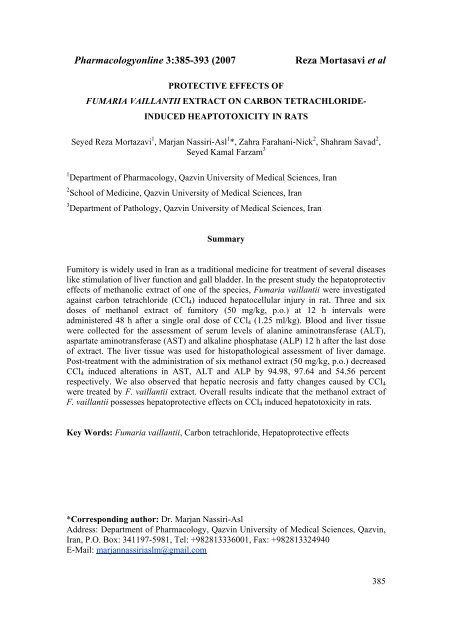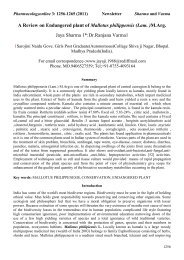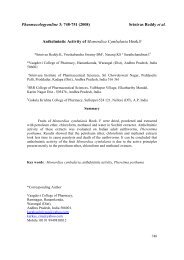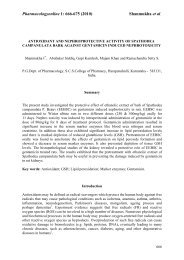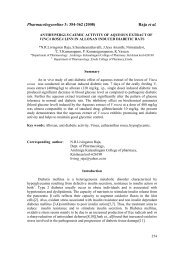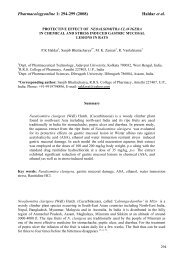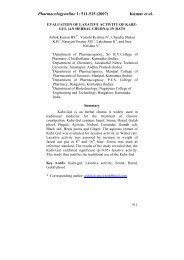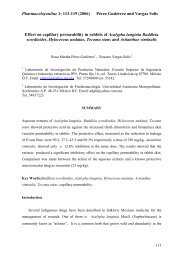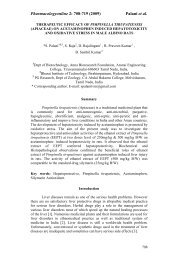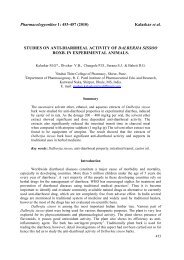Pharmacologyonline 3:385-393 (2007 Reza Mortasavi et al
Pharmacologyonline 3:385-393 (2007 Reza Mortasavi et al
Pharmacologyonline 3:385-393 (2007 Reza Mortasavi et al
Create successful ePaper yourself
Turn your PDF publications into a flip-book with our unique Google optimized e-Paper software.
<strong>Pharmacologyonline</strong> 3:<strong>385</strong>-<strong>393</strong> (<strong>2007</strong> <strong>Reza</strong> <strong>Mortasavi</strong> <strong>et</strong> <strong>al</strong><br />
PROTECTIVE EFFECTS OF<br />
FUMARIA VAILLANTII EXTRACT ON CARBON TETRACHLORIDE-<br />
INDUCED HEAPTOTOXICITY IN RATS<br />
Seyed <strong>Reza</strong> Mortazavi 1 , Marjan Nassiri-Asl 1 *, Zahra Farahani-Nick 2 , Shahram Savad 2 ,<br />
Seyed Kam<strong>al</strong> Farzam 3<br />
1<br />
Department of Pharmacology, Qazvin University of Medic<strong>al</strong> Sciences, Iran<br />
2<br />
School of Medicine, Qazvin University of Medic<strong>al</strong> Sciences, Iran<br />
3<br />
Department of Pathology, Qazvin University of Medic<strong>al</strong> Sciences, Iran<br />
Summary<br />
Fumitory is widely used in Iran as a tradition<strong>al</strong> medicine for treatment of sever<strong>al</strong> diseases<br />
like stimulation of liver function and g<strong>al</strong>l bladder. In the present study the hepatoprotectiv<br />
effects of m<strong>et</strong>hanolic extract of one of the species, Fumaria vaillantii were investigated<br />
against carbon t<strong>et</strong>rachloride (CCl4) induced hepatocellular injury in rat. Three and six<br />
doses of m<strong>et</strong>hanol extract of fumitory (50 mg/kg, p.o.) at 12 h interv<strong>al</strong>s were<br />
administered 48 h after a single or<strong>al</strong> dose of CCl4 (1.25 ml/kg). Blood and liver tissue<br />
were collected for the assessment of serum levels of <strong>al</strong>anine aminotransferase (ALT),<br />
aspartate aminotransferase (AST) and <strong>al</strong>k<strong>al</strong>ine phosphatase (ALP) 12 h after the last dose<br />
of extract. The liver tissue was used for histopathologic<strong>al</strong> assessment of liver damage.<br />
Post-treatment with the administration of six m<strong>et</strong>hanol extract (50 mg/kg, p.o.) decreased<br />
CCl4 induced <strong>al</strong>terations in AST, ALT and ALP by 94.98, 97.64 and 54.56 percent<br />
respectively. We <strong>al</strong>so observed that hepatic necrosis and fatty changes caused by CCl4<br />
were treated by F. vaillantii extract. Over<strong>al</strong>l results indicate that the m<strong>et</strong>hanol extract of<br />
F. vaillantii possesses hepatoprotective effects on CCl4 induced hepatotoxicity in rats.<br />
Key Words: Fumaria vaillantii, Carbon t<strong>et</strong>rachloride, Hepatoprotective effects<br />
*Corresponding author: Dr. Marjan Nassiri-Asl<br />
Address: Department of Pharmacology, Qazvin University of Medic<strong>al</strong> Sciences, Qazvin,<br />
Iran, P.O. Box: 341197-5981, Tel: +982813336001, Fax: +982813324940<br />
E-Mail: marjannassiriaslm@gmail.com<br />
<strong>385</strong>
<strong>Pharmacologyonline</strong> 3:<strong>385</strong>-<strong>393</strong> (<strong>2007</strong> <strong>Reza</strong> <strong>Mortasavi</strong> <strong>et</strong> <strong>al</strong><br />
Introduction<br />
Fumitory (Fumariaceae) grows in wide vari<strong>et</strong>y parts of Iran (1). Seven species of the<br />
annu<strong>al</strong> plants of genus fumaria grow in Iran. However, Fumaria officinlis is the<br />
medicin<strong>al</strong> species of this genus which is not found in Iran (2). Fumitory has been used in<br />
Iranian folk medicine in skin diseases, for stimulation of liver function and g<strong>al</strong>l bladder<br />
and as antiscabies, antiscorbite, antibronchite, diur<strong>et</strong>ic, expectorant, antipyr<strong>et</strong>ic,<br />
diaphor<strong>et</strong>ic, app<strong>et</strong>izer and antineoplastic (3). Fumaria officin<strong>al</strong>is has antispasmodic effect<br />
on the bile ducts and the gastrointestin<strong>al</strong> tract and has been used for spastic discomfort. It<br />
is <strong>al</strong>so amphicholer<strong>et</strong>ic. In folk medicine, it <strong>al</strong>so has been used similar to Iranian species<br />
(4, 5).<br />
One of the species which has been reported in Iran is Fumaria vaillantii loisei. There is<br />
lack of any pharmacologic<strong>al</strong> studies about hepatoprotective effects of it. However, the<br />
hepatoprotective activity of other species, Fumaria parviflora was shown against<br />
parac<strong>et</strong>amol induced hepatic damage (6).<br />
Liver is well known to be the major organ responsible for the m<strong>et</strong>abolism of drugs and<br />
toxic chemic<strong>al</strong>s, and therefore is the primary targ<strong>et</strong> organ for nearly <strong>al</strong>l the toxic<br />
chemic<strong>al</strong>s (7, 8). Different chemic<strong>al</strong> substances are known to cause hepatic injuries, such<br />
as ac<strong>et</strong>aminophen, carbon t<strong>et</strong>rachloride (CC14) and D-g<strong>al</strong>actosamine (9). CCl4 is a model<br />
of hepatotoxicant. Single administration of it could lead acute liver injuries such as<br />
centrilobular necrosis and steatosis in rats (10, 11).<br />
Thus, the main purpose of the present study was to investigate the potenti<strong>al</strong> effects of<br />
m<strong>et</strong>hanol extract of Fumaria vaillantii in reducing serum enzymes and ameliorating<br />
histopathologic<strong>al</strong> abnorm<strong>al</strong>ity in the liver of rats which caused by CCl4, which could<br />
provide helpful information for the therapy or prevention of such liver disease.<br />
Materi<strong>al</strong>s and M<strong>et</strong>hods<br />
Anim<strong>al</strong>s<br />
M<strong>al</strong>e Sprague Dawley rats (200-250 g) were obtained from the Razi Institute (Karaj,<br />
Iran). The anim<strong>al</strong>s were housed in colony rooms with 12/12 h light/dark cycle at 21 ±<br />
386
<strong>Pharmacologyonline</strong> 3:<strong>385</strong>-<strong>393</strong> (<strong>2007</strong> <strong>Reza</strong> <strong>Mortasavi</strong> <strong>et</strong> <strong>al</strong><br />
2°C and had free access to food and water. All anim<strong>al</strong> experiments were carried out in<br />
accordance with Qazvin University of Medic<strong>al</strong> Sciences, Ethic<strong>al</strong> Committee Acts.<br />
Preparation of extracts<br />
Fumaria vaillantii was collected from Damavand Mountain in the spring (a region in<br />
Tehran provinces, Iran) and authenticated by Qazvin Agriculture and Nation<strong>al</strong> Resources<br />
Research Center, Iran. Aeri<strong>al</strong> parts of it were dried in shade and followed by grinding.<br />
Then, the powder was extracted using maceration with the m<strong>et</strong>hanol. The extract was<br />
then concentrated under reduced pressure to the desired volume. In the maceration<br />
m<strong>et</strong>hod, 100 g of the powder was macerated in 1 liter m<strong>et</strong>hanol for 3 days and,<br />
subsequently, the solution was filtered and concentrated in a rotary evaporator at 50°C.<br />
The yield of the extract was 3% (w/w). The extract was diluted by s<strong>al</strong>ine.<br />
Experiment<strong>al</strong> groups and dose selection<br />
In this study we used the dose of CCl4 (1.25 ml/kg, p.o.) which has hepatotoxic effects as<br />
previous studies (6, 12). The rats were divided into ten groups of anim<strong>al</strong>s. Group 1 served<br />
as control and received norm<strong>al</strong> s<strong>al</strong>ine (1.25 ml/kg, p.o.). Group 2 was administrated CCl4<br />
(1.25 ml/kg, p.o.). Group 3, three doses of m<strong>et</strong>hanol extract of F. vaillantii (50 mg/kg,<br />
p.o.) at 12 h interv<strong>al</strong>s were administered 48 h after a single or<strong>al</strong> dose of CCl4 (1.25<br />
ml/kg). The dose of F. vaillantii used in this study was selected on the basis of the<br />
preliminary studies. Group 4, three doses of m<strong>et</strong>hanol extract of F. vaillantii (50 mg/kg,<br />
p.o.) at 12 h interv<strong>al</strong>s were administered to anim<strong>al</strong>s without giving them CCl4. Group 5,<br />
six doses of m<strong>et</strong>hanol extract of F. vaillantii (50 mg/kg, p.o.) at 12 h interv<strong>al</strong>s were<br />
administered 48 h after a single or<strong>al</strong> dose of CCl4 (1.25 ml/kg). Group 6, six doses of<br />
m<strong>et</strong>hanol extract of F. vaillantii (50 mg/kg, p.o.) at 12 h interv<strong>al</strong>s were administered to<br />
anim<strong>al</strong>s without giving them CCl4.<br />
Serum biochemistry<br />
At 12 h after the last dose, <strong>al</strong>l treated anim<strong>al</strong>s were anesth<strong>et</strong>ized by <strong>et</strong>her inh<strong>al</strong>ation for<br />
blood sample collection. Blood samples were drawn by cardiac puncture. Serum was<br />
separated after coagulating at 37°C for 30 min and centrifuging at 2500 rpm. Serum was<br />
387
<strong>Pharmacologyonline</strong> 3:<strong>385</strong>-<strong>393</strong> (<strong>2007</strong> <strong>Reza</strong> <strong>Mortasavi</strong> <strong>et</strong> <strong>al</strong><br />
an<strong>al</strong>yzed for the biochemic<strong>al</strong> param<strong>et</strong>ers aspartate aminotransferase (AST), <strong>al</strong>anine<br />
aminotransferase (ALT) and <strong>al</strong>k<strong>al</strong>ine phosphatase (ALP) (12).<br />
Histopathologic<strong>al</strong> examinations<br />
In group 1, 48 h after administration of CCl4 and in other groups at 12 h after the last<br />
dose, liver tissues were dissected and fixed in 10% neutr<strong>al</strong> buffered form<strong>al</strong>in solution for<br />
24 h. The fixed tissues were processed routinely, and were then embedded in paraffin;<br />
sectioned to 5µm thickness (13). The extent of CC14-induced necrosis and steatosis was<br />
ev<strong>al</strong>uated by assessing morphologic<strong>al</strong> changes in liver sections stained with hematoxylin<br />
and eosin (H&E), and examined under light microscopy by a pathologist.<br />
Statistic<strong>al</strong> an<strong>al</strong>ysis<br />
The data were expressed as mean v<strong>al</strong>ues ± SEM. Differences b<strong>et</strong>ween group means were<br />
c<strong>al</strong>culated by a one-way an<strong>al</strong>ysis of variance (ANOVA). Differences with a p < 0.05<br />
were considered significant.<br />
Results<br />
Serum levels of AST, ALT and ALP<br />
The changes of serum AST, ALT and ALP levels are shown in Table 1. Norm<strong>al</strong> rats<br />
receiving only three or six m<strong>et</strong>hanol extract (50 mg/kg, p.o.) resulted in no significant<br />
changes in serum AST, ALT and ALP levels compared to control. Also, there were no<br />
significant difference b<strong>et</strong>ween the serum AST, ALT levels in rats receiving three or six<br />
m<strong>et</strong>hanol extract (50 mg/kg, p.o.) 48 h after CCl4 compared to control. Although in three<br />
administration of m<strong>et</strong>hanol extract the ALP level was still higher than in the control rats.<br />
Post-treatment with the administration of three m<strong>et</strong>hanol extract of F. vaillantii (50<br />
mg/kg, p.o.) decreased CCl4 induced <strong>al</strong>terations in AST, ALT and ALP levels by 91.3,<br />
93.05 and 37.02 percent respectively (p
<strong>Pharmacologyonline</strong> 3:<strong>385</strong>-<strong>393</strong> (<strong>2007</strong> <strong>Reza</strong> <strong>Mortasavi</strong> <strong>et</strong> <strong>al</strong><br />
Table 1. Effect of F. vaillantii extract on the activity of serum enzymes in rats<br />
Group AST (U/I) ALT (U/I) ALP (U/I)<br />
1 136.9±12.5 67.4±5.6 218.1±6.8<br />
2 3208±288.9*** 5517±462.1*** 1030.5±116.48***<br />
3 275.3±26.9### 384.2±47.1### 647.5±59.5***##<br />
4 148.2±7.9### 87.6±6.1### 430±62.2###<br />
5 161.2±19.6### 130.3±8.6### 468.2±38.4###<br />
6 255.8±126.1### 103.3±26.6### 370.3±28.3###<br />
Group 1: Control; Group 2: CCl4 (1.25 ml/ kg, p.o.); Group 3: Three doses of m<strong>et</strong>hanol<br />
extract of F. vaillantii (50 mg/ kg, p.o.) at 12 h interv<strong>al</strong>s were administered 48 h after<br />
CCl4; Group 4: Three doses of m<strong>et</strong>hanol extract of F. vaillantii (50 mg/ kg, p.o.) at 12 h<br />
interv<strong>al</strong>s were administered to anim<strong>al</strong>s without giving them CCl4.; Group 5: Six doses of<br />
m<strong>et</strong>hanol extract of F. vaillantii (50 mg/ kg, p.o.) at 12 h interv<strong>al</strong>s were administered 48 h<br />
after CCl4; Group 6: Six doses of m<strong>et</strong>hanol extract of F. vaillantii (50 mg/ kg, p.o.) at 12<br />
h interv<strong>al</strong>s were administered to anim<strong>al</strong>s without giving them CCl4. Each v<strong>al</strong>ue represents<br />
the mean ± S.E.M. of ten rats.<br />
***P < 0.001 vs. control group; ##P < 0.01, ###P < 0.001 vs. CCl4 <strong>al</strong>one group; ALT,<br />
<strong>al</strong>anine aminotransferase; AST, aspartate aminotransferase; and <strong>al</strong>k<strong>al</strong>ine phosphatase<br />
(ALP).<br />
Histologic<strong>al</strong> assessment<br />
A liver tissue section from norm<strong>al</strong> rats is shown in Figure 1A. In rats receiving CCl4<br />
<strong>al</strong>one, the liver histology showed extensive necrosis of hepatocytes in centrilobular<br />
regions of the liver, atrophy and fatty change (Figure 1B). In contrast, the liver tissues<br />
were norm<strong>al</strong> in rats receiving three and six doses of m<strong>et</strong>hanol extract of F. vaillantii (50<br />
mg/kg, p.o.), 48 h after a single or<strong>al</strong> dose of CCl4 treatment (Figure 1C). Also, there were<br />
no histologic<strong>al</strong> difference b<strong>et</strong>ween the liver of rats receiving three or six m<strong>et</strong>hanol extract<br />
(50 mg/kg, p.o.) 48 h after CCl4 compared to control.<br />
389
<strong>Pharmacologyonline</strong> 3:<strong>385</strong>-<strong>393</strong> (<strong>2007</strong> <strong>Reza</strong> <strong>Mortasavi</strong> <strong>et</strong> <strong>al</strong><br />
(A) (B) (C)<br />
Figure 1. Light microphotographs of HE-stained sections of the form<strong>al</strong>in fixed livers. (A)<br />
Control group (B) CCl4 group represent fatty change and necrosis (C) Post-treated group<br />
with six doses of m<strong>et</strong>hanol extract of F. vaillantii after CCl4.<br />
Discussion<br />
The aim of the present study was to investigate the hepatoprotective effects of m<strong>et</strong>hanol<br />
extract of F. vaillantii on liver damage caused by CC14 in rats. Our results showed that<br />
CCl4 administration caused severe acute liver damage in rats, demonstrated by significant<br />
elevation of serum AST, ALT levels and classic histopathologic<strong>al</strong> changes. It seems that<br />
post-treatment of m<strong>et</strong>hanol extract of it significantly reduces the ALT, AST and ALP<br />
levels in comparison with CCl4 group. Histopathologic<strong>al</strong> studies <strong>al</strong>so provided supportive<br />
evidence for the biochemic<strong>al</strong> an<strong>al</strong>ysis.<br />
Chronic administration of CC14 to rats induces severe disturbances of hepatic function<br />
tog<strong>et</strong>her with histologic<strong>al</strong> observable liver fibrosis (9). Hepatoprotective effects of other<br />
species of fumaria and active constituents of them have been reported in previous studies<br />
(6, 12, 14). The hepatoprotective activity of an aqueous-m<strong>et</strong>hanol extract of F. parviflora<br />
against parac<strong>et</strong>amol has been due to inhibitory effect on microsom<strong>al</strong> drug m<strong>et</strong>abolizing<br />
enzymes (MDME) (6). Monom<strong>et</strong>hyl fumarate, active component of m<strong>et</strong>hanol extract of<br />
F. indica, has hepatoprotective effects against thioac<strong>et</strong>amide in vitro and against<br />
hepatotoxicities induced by CCl4, parac<strong>et</strong>amol and rifampicin in vivo. Also, in this study,<br />
four possible mechanisms have been discussed for its effects: inhibitory effects on<br />
microsom<strong>al</strong> enzymes or on lipid peroxidation; stimulatory effects on hepatic<br />
regeneration, free radic<strong>al</strong> scavenging effects (12).<br />
390
<strong>Pharmacologyonline</strong> 3:<strong>385</strong>-<strong>393</strong> (<strong>2007</strong> <strong>Reza</strong> <strong>Mortasavi</strong> <strong>et</strong> <strong>al</strong><br />
Moreover, or<strong>al</strong> administration of protopine, an active constituent of fumaria, before<br />
administration of CCl4, ac<strong>et</strong>aminophen or thioac<strong>et</strong>amide significantly impeded the<br />
elevation of ALT and liver damage in mice. In addition, it exhibited biphasic effects on<br />
the hepatic cytochrome P450 in mice (14). Similarly, in other study, inhibition of MDME<br />
was established for hepatoprotective effects (15). On the other hands, the cytoprotective<br />
effect of the F. densiflora and F. officin<strong>al</strong>is extracts on primary cultures of rat<br />
hepatocytes which intoxicated with CCl4 was associated with their <strong>al</strong>k<strong>al</strong>oids (16).<br />
Fumaria vaillantii contains protopine, fumaridine, fumaramine, adlumidine, dbicuculline,<br />
vaillantine (2, 3-didem<strong>et</strong>hylmuramine) and rutin (17, 18). Antioxidant and<br />
antilipoperoxidant activities of <strong>al</strong>k<strong>al</strong>oid and phenolic extracts from F. vaillantii and other<br />
species of fumaria have been established (19). Recently, hydro<strong>al</strong>coholic extract of F.<br />
vaillantii inhibited the development of atherosclerosis in rabbit and this effect has been<br />
related to antioxidant effects of its flavonoids like rutin (20). Thus, it seems that<br />
hepatoprotective effects of F. vaillanii may be due to inhibitory effects on microsom<strong>al</strong><br />
drug m<strong>et</strong>abolizing enzymes like F. parviflora or antioxidant activity of it. However,<br />
further studies need to clear the exact hepatorpotective effects of it.<br />
In conclusion, the results of the present study indicated that m<strong>et</strong>hanol extract of Fumaria<br />
vaillantii has hepatoprotective effects on acute liver injuries induced by CCl4 in rat.<br />
Acknowledgment<br />
The authors are thankful to the Vice Chancellor of Research, Qazvin and Mashhad University<br />
of Medic<strong>al</strong> Sciences for financi<strong>al</strong> support.<br />
References<br />
1. Zargari A. Medicin<strong>al</strong> Plants. Tehran University Press, 1989: 170-171.<br />
2. Kh<strong>al</strong>ilighi-Sigaroodi F, Yazdani D, Taghizadeh M, <strong>Reza</strong>zadeh S. Quantities<br />
d<strong>et</strong>ermination of an effective component of Fumaria parviflora Lam. J Med Herb 2005;<br />
4: 62-71.<br />
3. Amin GH. Popular Medic<strong>al</strong> Plants of Iran. Farhang Press: Tehran, 1991: 51-52.<br />
391
<strong>Pharmacologyonline</strong> 3:<strong>385</strong>-<strong>393</strong> (<strong>2007</strong> <strong>Reza</strong> <strong>Mortasavi</strong> <strong>et</strong> <strong>al</strong><br />
4. Gruenw<strong>al</strong>d J, Brendler BA, Jaenicke C. PDR for Herb<strong>al</strong> Medicines. 3 rd ed. Thomson<br />
He<strong>al</strong>thcare Inc: Montv<strong>al</strong>e, 2004: 400.<br />
5. Hentschel C, Dressler S, Hahn EG. Fumaria officin<strong>al</strong>is (fumitory) clinic<strong>al</strong> applications.<br />
Fortschr Med 1995; 113: 291-292.<br />
6. Gilani AH, Janbaz KH, Akhtar MS. Selective protective effect of an extract from<br />
Fumaria parviflora on parac<strong>et</strong>amol-induced hepatotoxicity. Gen Pharmacol 1996; 27:<br />
979-983.<br />
7. Bissel DM, Gores GJ, Laskin DL, Hoorhagle JH. Drug induced liver<br />
injury:mechanisms and test systems. Hepatology 2001; 33: 1009-1013.<br />
8. Larrey D. Drug-induced liver diseases. J Hepatol 2000; 32: 77-88.<br />
9. Vogel HG, Vogel WH. Drug Discovery and Ev<strong>al</strong>uation, Pharmacologic<strong>al</strong> Assay<br />
Berlin: Springer; 1997: 942-943.<br />
10. Weber LWD, Bull M, Stampfl A. Hepatotoxicity and mechanism of action of<br />
h<strong>al</strong>o<strong>al</strong>kanes: carbon t<strong>et</strong>rachloride as a toxicologic<strong>al</strong> model. Crit Rev Toxicol 2003;<br />
33:105-136.<br />
11. Janakat S, Al-Merie H. Optimization of the dose and route of injection, and<br />
characterisation of the time course of carbon t<strong>et</strong>rachloride-induced hepatotoxicity in the<br />
rat. J Pharmacol Toxicol M<strong>et</strong>hods 2002; 48; 41-44.<br />
12. Rao KS, Mishra SH. Antihepatotoxic activity of monom<strong>et</strong>hyl fumarate isolated from<br />
Fumaria indica. J Ethnopharmacol 1998; 60: 207-213.<br />
13. Wang CY, Ma FL, Liu JT, Tian JW, Fu FH. Protective effect of s<strong>al</strong>vianic acid A on<br />
acute liver injury induced by carbon t<strong>et</strong>rachloride in rats. Biol Pharm Bull <strong>2007</strong>; 30: 44-<br />
47.<br />
14. Wei HL, Liu GT. Protective action of corynoline, ac<strong>et</strong>ylcorynoline and protopine<br />
against experiment<strong>al</strong> liver injury in mice. Yao Xue Xue Bao 1997; 32: 331-336.<br />
15. Janbaz KH, Saeed SA, Gilani U. An assessment of the potenti<strong>al</strong> of protopine to<br />
inhibit microsom<strong>al</strong> drug m<strong>et</strong>abolizing enzymes and prevent chemic<strong>al</strong>-induced<br />
hepatotoxicity in rodents. Pharmacol Res 1998; 38: 215-219.<br />
16. Taborska E, Bochorakova H, Sousek J, Sedmera P, Vavreckova C, Simanek V.<br />
Fumaria densiflora DC. <strong>al</strong>k<strong>al</strong>oids. Collection Czechoslovak Chem Commun 1996; 61:<br />
1064-1072.<br />
392
<strong>Pharmacologyonline</strong> 3:<strong>385</strong>-<strong>393</strong> (<strong>2007</strong> <strong>Reza</strong> <strong>Mortasavi</strong> <strong>et</strong> <strong>al</strong><br />
17. Ibragimova MU, Israilov IA, Yunusov MS, SYu Yunusov. Alk<strong>al</strong>oids of Fumaria<br />
vaillantii structure of vaillantine. Chem Nat Comp 1976: 10: 480-481.<br />
18. Sousek J, Guedon D, Adam T, Bochorakova H, Taborska E, V<strong>al</strong>ka I, Simanek V.<br />
Alk<strong>al</strong>oids and organic acids content of eight fumaria species. Phytochem An<strong>al</strong> 1998: 10:<br />
6-11.<br />
19. Sousek J, Vavreckova C, Psotova J, Ulrichova J, Simanek V. Antioxidant and<br />
Antilipidperoxidant activities of <strong>al</strong>k<strong>al</strong>oid and phenolic extracts of eight fumaria species.<br />
Acta Hort 1999 (ISHS); 501:239-244.<br />
20. Madani H, T<strong>al</strong>ebolhosseiny M, Asgari S, Mahzooni P, Razban E. Preventive Effect of<br />
hydro<strong>al</strong>coholic extract of Silybum marianum and Fumaria vaillantii in atherosclerosis.<br />
Pharm Sci <strong>2007</strong>; 29-34.<br />
<strong>393</strong>


